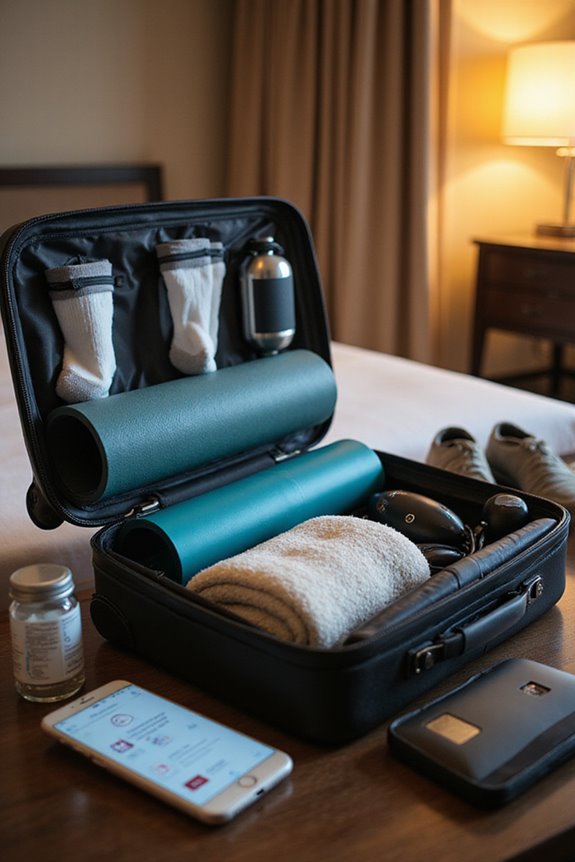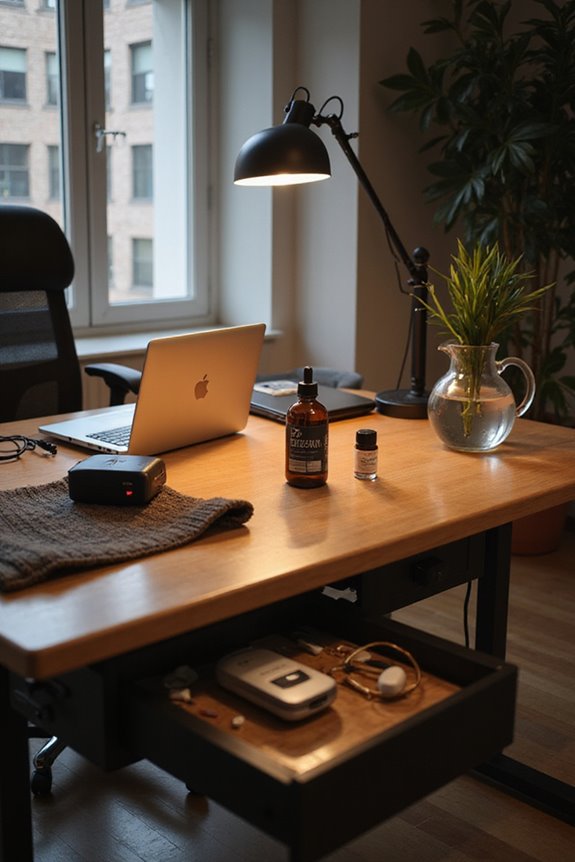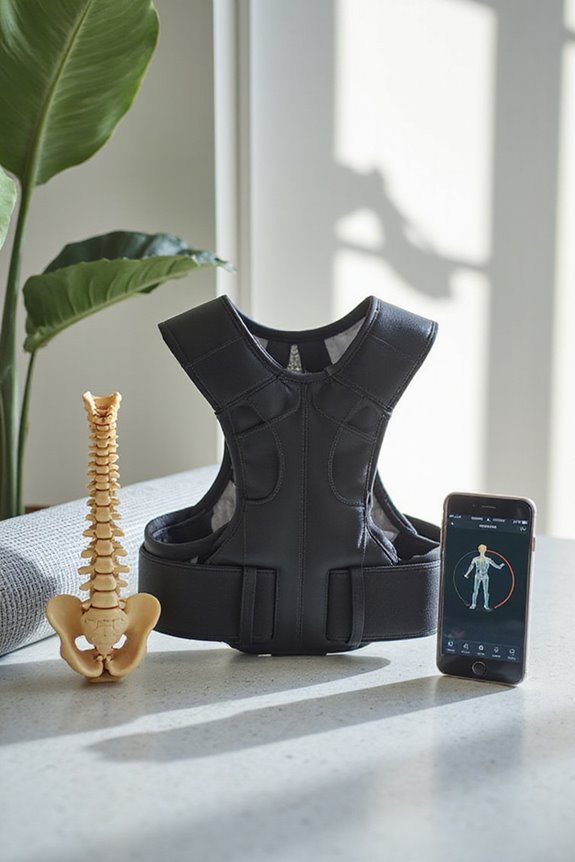To manage pain during business travel, planning is essential. Pre-trip checklists should include medication reviews, hydration strategies, and anti-inflammatory snacks. Utilize travel accessories such as seat cushions, lumbar pillows, and footrests to enhance comfort. Maintain hydration with a reusable water bottle and electrolyte supplements. Incorporate movement through scheduled breaks or workouts, and manage sleep patterns to reduce jet lag. For a thorough approach to travel wellness, additional strategies and tools can be employed.
Key Takeaways
- Pack essential medications and consult with healthcare providers to address pain management before traveling.
- Use travel seat cushions and lumbar support pillows to maintain comfort and reduce strain during long periods of sitting.
- Incorporate hydration by carrying a reusable water bottle and consuming hydrating snacks to minimize discomfort and swelling.
- Schedule regular movement breaks, including stretches or short walks, to enhance circulation and alleviate stiffness while traveling.
- Prioritize sleep by adjusting your schedule gradually and establishing a routine to combat jet lag and maintain overall well-being.
Planning Ahead to Minimize Discomfort
Planning ahead is essential for minimizing discomfort during business travel. A thorough pre-trip checklist should include essential medications, ensuring that a medication review is conducted with healthcare providers. This facilitates proper medication alignment with travel schedules, avoiding interruptions.
Key strategies include:
- Hydration: Maintain fluid intake to reduce swelling and flush toxins.
- Nutrition: Pack anti-inflammatory snacks to sustain energy and stabilize blood sugar levels.
- Seating Arrangements: Pre-arrange seating to promote comfort and reduce strain.
Rest is equally vital. Schedule adequate sleep and incorporate brief breaks during travel. By implementing these strategies, individuals can greatly enhance their travel experience, fostering a sense of well-being and belonging amidst the challenges of business travel. Additionally, consider using a heating pad with multiple heat settings to relieve any discomfort during long flights or car rides.
Choosing the Right Travel Accessories
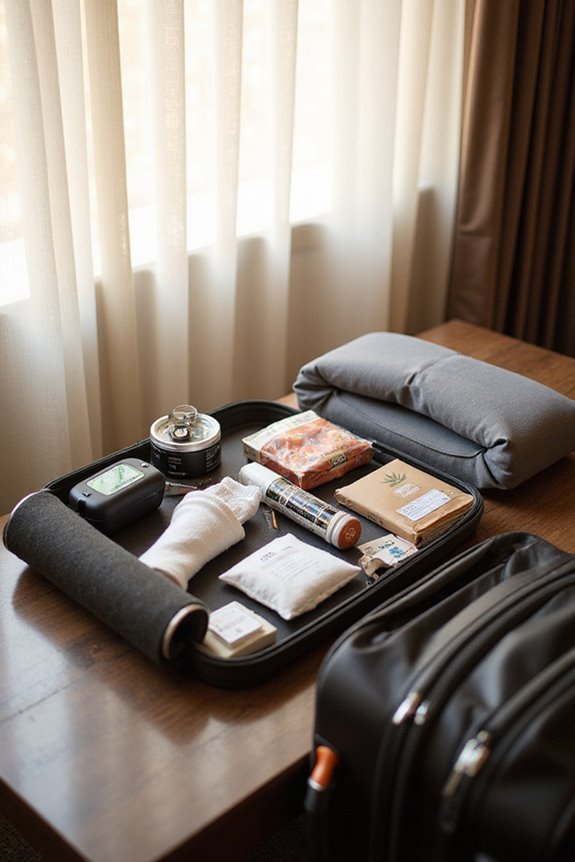
Choosing the right travel accessories can greatly enhance comfort during business travel, particularly for those prone to pain or discomfort.
Ergonomic Designs
- Travel seat cushions provide support for pelvic, hip, and back pain, ensuring comfort during extended sitting.
- Lumbar support pillows are compact and can reduce lower back pain effectively.
Portable Solutions
- Compact pain relief devices, like H-Wave, are lightweight and rechargeable, allowing pain management on the go.
- Airplane footrests and foot hammocks improve circulation, preventing swelling and muscle stiffness. Additionally, using heating pads for neck pain can provide soothing relief during long journeys.
Hygienic Materials
– Many accessories use breathable, stain-resistant, and hypoallergenic materials, ensuring safety and comfort.
Selecting these items can facilitate better health outcomes, making business travel more enjoyable and productive for all.
Staying Hydrated and Nourished

Maintaining hydration and proper nutrition is essential for business travelers, as dehydration can greatly impact physical comfort and overall performance.
Hydration Strategies
- Carry a reusable water bottle for consistent sipping throughout the day.
- Set hydration reminders on devices to guarantee regular water intake.
- Drink water before, during, and after flights to maintain fluid balance.
Electrolyte Balance
- Replenish lost electrolytes with low-sugar powders or tablets mixed with water.
- Avoid excessive caffeine and alcohol, as they exacerbate dehydration.
- Incorporate hydrating foods, such as fruits and vegetables, to support fluid intake.
Incorporating Movement During Travel
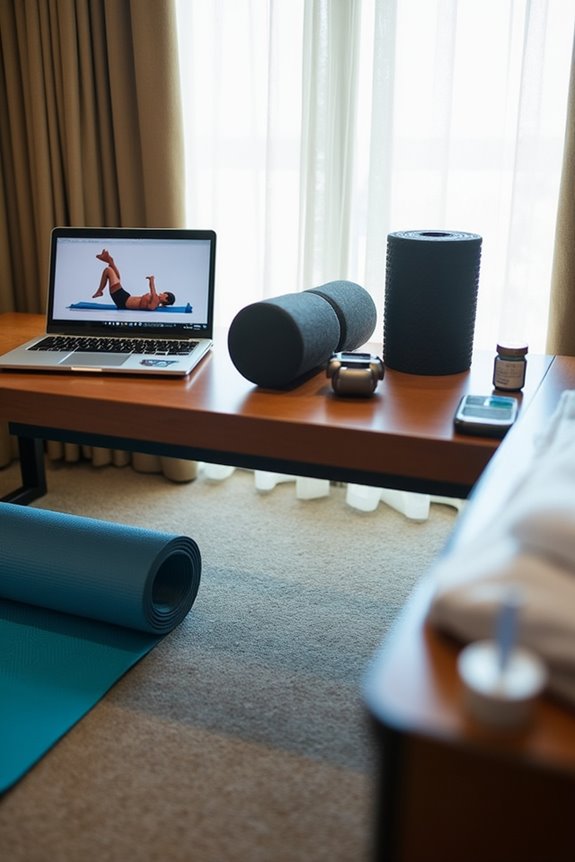
Incorporating movement during business travel is essential for enhancing both physical and mental well-being. Despite the challenges, such as tight schedules and unfamiliar environments, movement breaks can markedly mitigate stress and health risks associated with prolonged sitting.
Strategies for Movement:
- Utilize hotel workouts: Engage in available hotel gyms, swimming pools, or in-room exercises.
- Schedule movement breaks: Incorporate short walks or stretches during layovers or waiting periods.
- Opt for low-impact activities: Focus on bodyweight exercises or walking to nearby meetings.
Benefits of Movement:
- Reduces obesity risks and supports cardiovascular health.
- Enhances mental clarity, energy levels, and productivity.
- Provides grounding and calming effects in busy travel settings.
Regular movement fosters a sense of belonging and well-being, vital for effective business travel.
Managing Sleep and Jet Lag Effectively
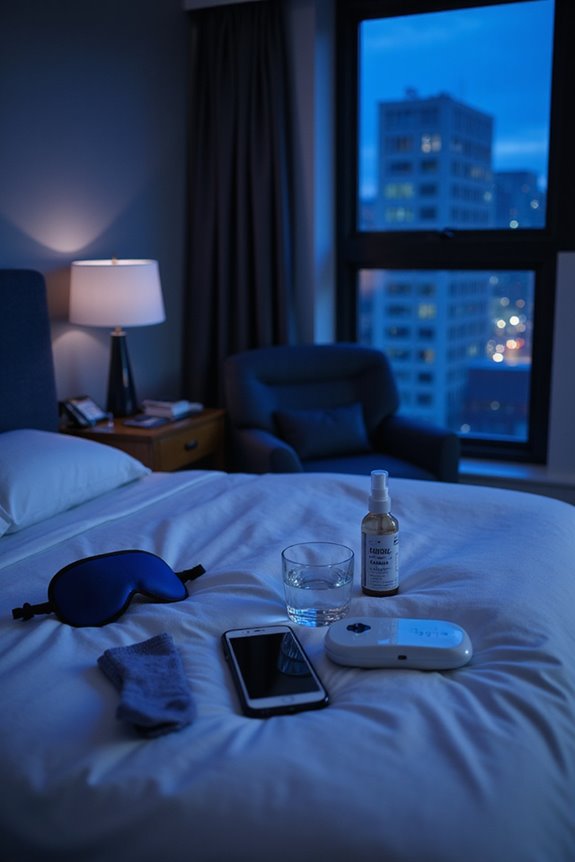
Managing sleep and jet lag effectively is essential for business travelers aiming to maintain peak performance. Disruption of circadian rhythms due to rapid time zone changes can lead to fatigue and decreased alertness. Here are strategies to enhance sleep hygiene and mitigate jet lag:
- Gradually adjust sleep schedules before travel.
- Utilize jet lag calculators for personalized plans.
- Choose flights arriving in the afternoon or early evening.
- Limit heavy meals, caffeine, and alcohol before bedtime.
- Maintain hydration and opt for light meals during flights.
Upon arrival, implement light exposure therapy and establish a regular sleep routine. Avoid excessive caffeine and monitor for persistent symptoms. By addressing these factors, business travelers can greatly reduce the impact of jet lag on their productivity.
Handling Financial and Administrative Stress
As business travel costs continue to rise, financial and administrative stress becomes a significant concern for many professionals. The projected US business travel spending of $472 billion in 2024 underscores the importance of effective budget strategies.
To manage these pressures, companies can implement the following measures:
- Advance Booking: Secure better rates before travel dates.
- Clear Travel Policies: Establish guidelines for spending and reimbursements.
- Expense Tracking: Utilize travel expense management software to streamline approvals.
- Flexible Bookings: Prioritize refundable options to minimize cancellation costs.
- Regular Budget Reviews: Compare actual spending against forecasts to maintain control.
Prioritizing Safety and Health During Trips
Prioritizing safety and health during business trips has become essential as the landscape of travel continues to evolve. A significant 37% of seasoned travelers now view illness or injury as their top concern, surpassing civil unrest and terrorism. This shift underscores the increasing awareness of health risks.
To mitigate these risks, companies implement robust safety protocols, including:
- Detailed travel safety guidelines.
- Pre-trip risk assessments to identify potential hazards.
- Access to emergency medical support while traveling.
Additionally, technology plays an important role, with travel health apps providing real-time alerts and assistance. As climate change exacerbates travel disruptions, awareness of environmental hazards is vital. By prioritizing health and safety, travelers can navigate their journeys with greater confidence and security.
Frequently Asked Questions
What Should I Do if I Experience Severe Pain While Traveling?
When severe pain occurs while traveling, it’s essential to prioritize pain management. Seek immediate medical assistance, notify emergency contacts, and utilize available resources to guarantee safety and comfort throughout the journey, fostering a sense of belonging and support.
Are There Specific Exercises for Pain Relief During Layovers?
During layovers, incorporating layover stretches and in-flight yoga can alleviate discomfort. Simple movements like hip openers, neck stretches, and ankle circles foster a sense of community, encouraging travelers to prioritize their well-being together.
How Can I Find Accessible Seating at Airports?
Finding accessible seating at airports can feel like searching for a needle in a haystack. However, with airport accessibility maps, websites, and customer service, travelers can easily discover comfortable seating options to enhance their journey.
What Natural Remedies Help Alleviate Travel-Related Discomfort?
Natural remedies like herbal supplements, such as turmeric and ginger, alongside essential oils like lavender and peppermint, can effectively alleviate travel-related discomfort, fostering a sense of belonging and comfort during journeys for those seeking relief.
Can Travel Insurance Cover Pain Management Expenses?
Travel insurance policies may cover pain management expenses, especially for acute situations, but coverage limits vary considerably. Pre-existing conditions often require disclosure, and specific plans can enhance protection, ensuring travelers feel secure during their journeys.

